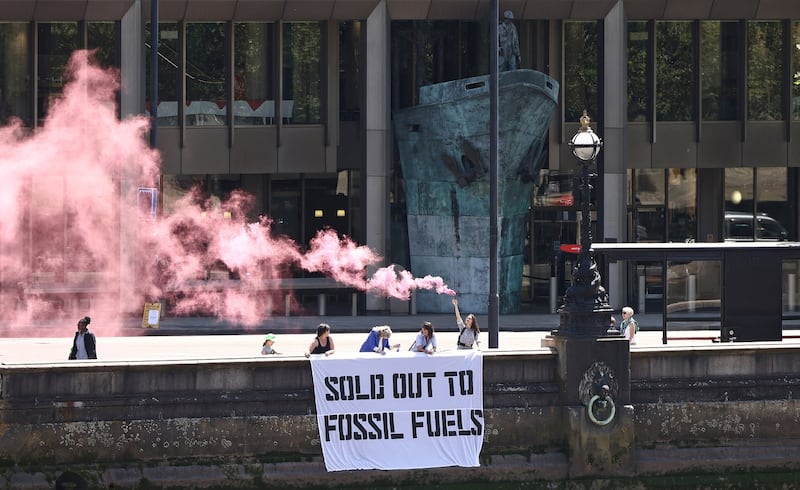The global shipping industry on Friday agreed to reduce planet-warming greenhouse gasses (GHG) to net zero “by or around 2050,” after China and others opposed a stricter emissions target despite mounting pressure.
The deal was agreed to by the 175 member states. It came at the end of a five-day meeting at the London headquarters of the International Maritime Organization (IMO), the United Nations’ global shipping regulator.
Maritime nations agreed on a revised strategy to "peak GHG emissions from international shipping as soon as possible and to reach net-zero GHG emissions by or around, i.e. close to 2050," a statement from the IMO said.
The less firm deadline was agreed to take account of “different national circumstances,” it added.
“This outcome is far from perfect, but countries came together and got it done - and it gives us a shot at 1.5 C,” said Vanuatu’s climate change minister, Ralph Regenvanu.
Previously, the shipping industry had targeted cutting its emissions by at least half from 2008 to 2050. Most of the world’s 100,000 cargo ships are powered by highly polluting diesel.
Pacific island nations had been pushing for more ambitious targets, calling for a 50% reduction by 2030 and a 96% emissions cut by 2040. Rich countries, including the United States, backed the demand.
Due to pushback from China, Brazil, Saudi Arabia and several other countries, the proposed strategy resulted in “indicative checkpoints” rather than a hard target to cut total annual GHG emissions “by at least 20%, striving for 30%, by 2030” and “by at least 70%, striving for 80%, by 2040,” compared to 2008 levels.
After the deal was agreed, Tuvalu’s negotiator said he was “very disappointed with a strategy which falls short of what we needed,” while the Marshall Islands negotiator said he had “mixed feelings” with more work to be done.
John Maggs, president of the environmental group Clean Shipping Coalition, said that “one of the reasons we’ve got this ridiculously caveated 2050 language is because of China, and one of the reasons that we don’t have stronger 2030 targets is because of Japan.”
On Monday, China’s negotiator had argued at the meeting that trade and development are as “existential” issues as climate change and that the emission targets should be “practical, reasonable and feasible,” with their impact properly assessed.
Scientists consider keeping global warming below the critical threshold of 1.5 degrees Celsius above pre-industrial levels the limit to stave off climate change’s most catastrophic and irreversible effects.

The agreement is lacking, experts say
Experts and environmentalists said the agreement falls short of what’s needed to curb warming to agreed temperature limits.
“There is no excuse for this wish and a prayer agreement. They knew what the science required, and that a 50% cut in emissions by 2030 was both possible and affordable,” said John Maggs, president of the environmental Clean Shipping Coalition.
“Instead the level of ambition agreed is far short of what is needed to be sure of keeping global heating below 1.5C, and the language seemingly contrived to be vague and non-committal.”
The global shipping industry, carrying up to 90% of trade goods, is responsible for around 3% of global GHG emissions. It is roughly equivalent to the emissions of Germany and more than the entire aviation industry, which is aiming to reach net zero by 2050.
The International Council on Clean Transportation (ICCT) said the new targets are incompatible with the Paris Agreement’s aim to keep global temperature rise to 1.5C by 2100.
“By our new estimates of the revised strategy, international shipping will exceed its current share of the world’s 1.5 C carbon budget by approximately 2032 but will not exceed the well below 2 C carbon budget (“well below” interpreted as 1.7 C) if it follows the emissions reduction pathway implied by this revised strategy,” said Bryan Comer, the marine program lead at the ICCT.
Experts have said the shipping industry must cut emissions by 45% by 2030 and reach net zero by 2050 to keep on track with the 1.5 C temperature goal.
Attempts to impose a levy on emissions from international shipping to fund climate action were unsuccessful, but it is still in consideration despite attempts to block it.
“Ultimately, it’s not the targets but the incentives we put in place to meet them. So we in the Pacific are going to keep up a strong fight for a levy that gets us to zero emissions by 2050,” Regenvanu said.
